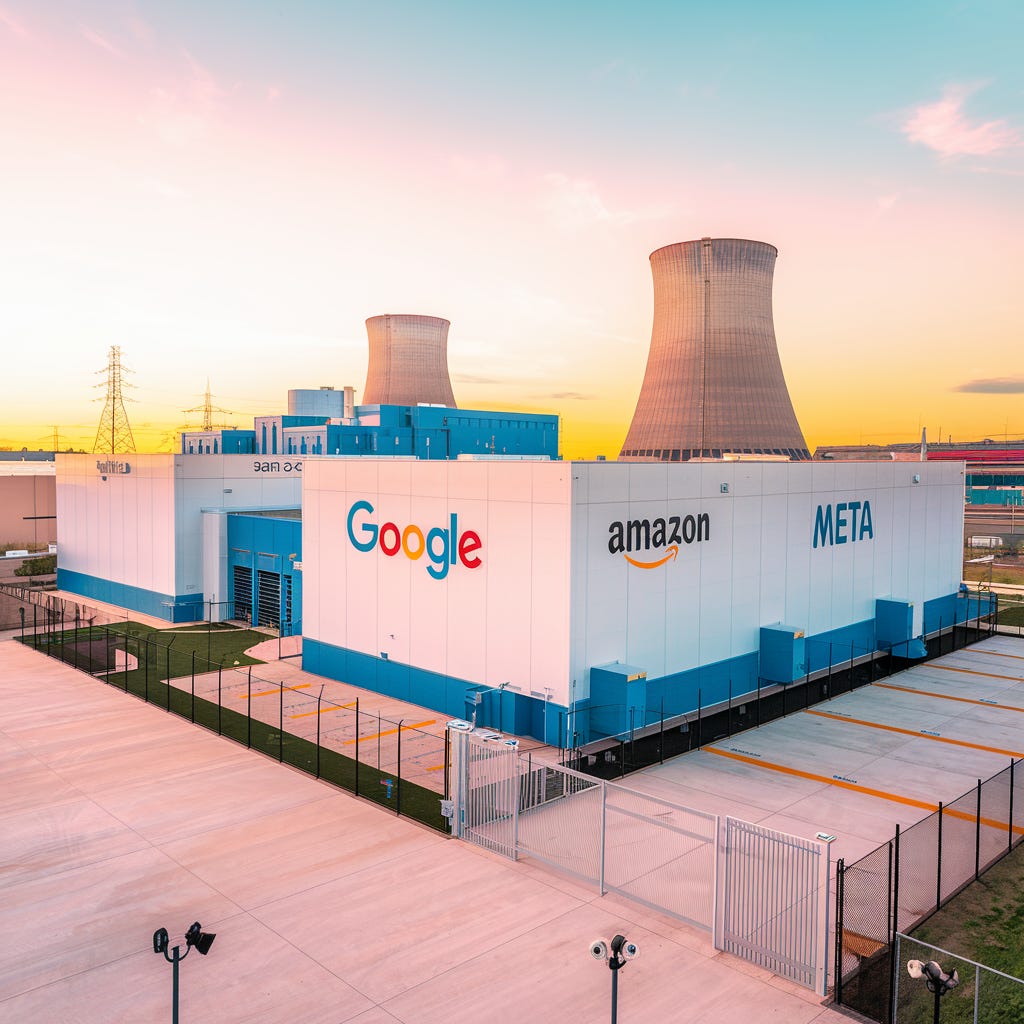Tech Giants Bet Big on Nuclear
Why Google, Amazon, and Meta Are Doubling Down on Nuclear Energy
The energy landscape is shifting—fast.
In a move that could redefine global energy markets, Google, Amazon, and Meta have joined forces to triple global nuclear capacity by 2050.
This is not just another climate pledge; it’s a strategic shift that signals a major transformation in how Big Tech secures the energy it desperately needs.
At the heart of this commitment is a simple truth: AI, cloud computing, and data centers are consuming electricity at unprecedented rates.
The demand is skyrocketing, and traditional renewables alone won’t cut it.
To keep up, the tech giants are making a high-stakes bet on nuclear power—specifically, Small Modular Reactors (SMRs)—as the backbone of their future energy strategy.
Let’s break down what’s happening, why it matters, and how this nuclear pivot could reshape the future of data centers and digital infrastructure.
The Pledge: A Historic Commitment to Nuclear Energy
Announced at CERAWeek 2025, this nuclear expansion pledge aims to increase global nuclear power output to over 1 million megawatts.
This is triple today’s nuclear capacity, a scale-up that could dramatically alter the world’s energy mix.
Tech giants aren’t alone in this push—governments, financial institutions, and industrial powerhouses are backing the initiative.
Companies like Dow, Occidental, and Allseas have also signed on, recognizing nuclear as a clean, reliable, and scalable energy source.
“As economies expand, the need for reliable, clean, and resilient energy is paramount. Nuclear power offers a pathway to achieve that.”
— Urvi Parekh, Head of Global Energy, Meta
But why now? The answer lies in one word: demand.
AI and Data Centers: The Energy Crisis No One Saw Coming
Data centers already account for 1% of global electricity consumption—and that number is expected to triple by 2026.
The Electric Power Research Institute projects that by 2030, data centers could consume 9% of all electricity in the U.S. alone.
The culprit? Artificial Intelligence.
Generative AI workloads require exponentially more power than traditional computing. As Amazon Web Services’ Kevin Miller put it:
“AI is driving a significant increase in the amount of power required on the grid.”
The reality is that while wind and solar energy are growing, they lack the reliability and scalability needed to power the next generation of AI-driven infrastructure. Nuclear fills this gap.
The Rise of Small Modular Reactors (SMRs): The Future of Clean Power?
Unlike traditional nuclear reactors, SMRs are smaller, faster to build, and easier to deploy. They offer continuous baseload power, making them ideal for high-energy industries like cloud computing and AI.
Tech giants are already investing heavily in SMRs:
Amazon has poured over $1 billion into nuclear projects, including a $500M investment in an SMR project with Dominion Energy.
Google has struck deals to purchase nuclear power from Kairos Power, with plans for six SMRs online by 2035.
Meta is exploring 1.4 gigawatts of new nuclear generation capacity across the U.S.
The U.S. Department of Energy is also backing this shift, with $900 million in funding to accelerate SMR deployment.
“Modular reactors are a huge piece of how we’re going to solve this puzzle.”
— Jennifer Granholm, U.S. Secretary of Energy
The message is clear: nuclear isn’t just a backup plan—it’s becoming a core component of the tech industry’s energy future.
Why This Matters for Data Centers and the Digital Economy
This nuclear pivot is about more than just power—it’s about the entire digital economy.
Reliable, 24/7 Power
Unlike wind or solar, nuclear energy doesn’t fluctuate based on weather conditions.
This is critical for data centers that need uninterrupted power.
Climate Commitments
Tech companies have aggressive net-zero targets.
Nuclear’s low-carbon footprint helps them stay on track.
Energy Security & Cost Stability
Energy markets are volatile. Nuclear locks in long-term pricing, shielding companies from fossil fuel price swings.
“Nuclear power will be pivotal in building a reliable, secure, and sustainable energy future.”
— Lucia Tian, Google
This also changes how data centers are built. Future facilities may co-locate next to nuclear plants, forming hyper-efficient energy hubs.
The Road Ahead: What to Watch for Next
While this pledge is a bold step, tripling nuclear capacity is no small feat. The biggest challenges ahead include:
Regulatory Hurdles – Nuclear projects face long approval timelines in many countries.
Financing & Cost – Despite tech’s backing, nuclear is capital-intensive.
Public Perception – The industry must address safety concerns and misinformation.
That said, the momentum is real. With Big Tech leading the charge, expect faster nuclear innovation, policy shifts, and new financing models to emerge.
Final Thoughts: A Defining Moment for Energy and Tech
We’re witnessing a historic energy shift. The world’s most powerful tech companies are placing nuclear at the center of their growth strategy—not as a side investment, but as a core necessity.
For data center operators, investors, and the broader digital infrastructure space, this signals a paradigm shift in how energy and technology will intersect in the coming decades.
This isn’t just about keeping the lights on—it’s about powering the future of AI, cloud computing, and beyond.
And it’s happening now.
What’s your take?
Do you see nuclear as the future of clean energy?
How will this impact data center investments in the next decade?
Drop your thoughts in the comments or reply to this email—I’d love to hear from you.

